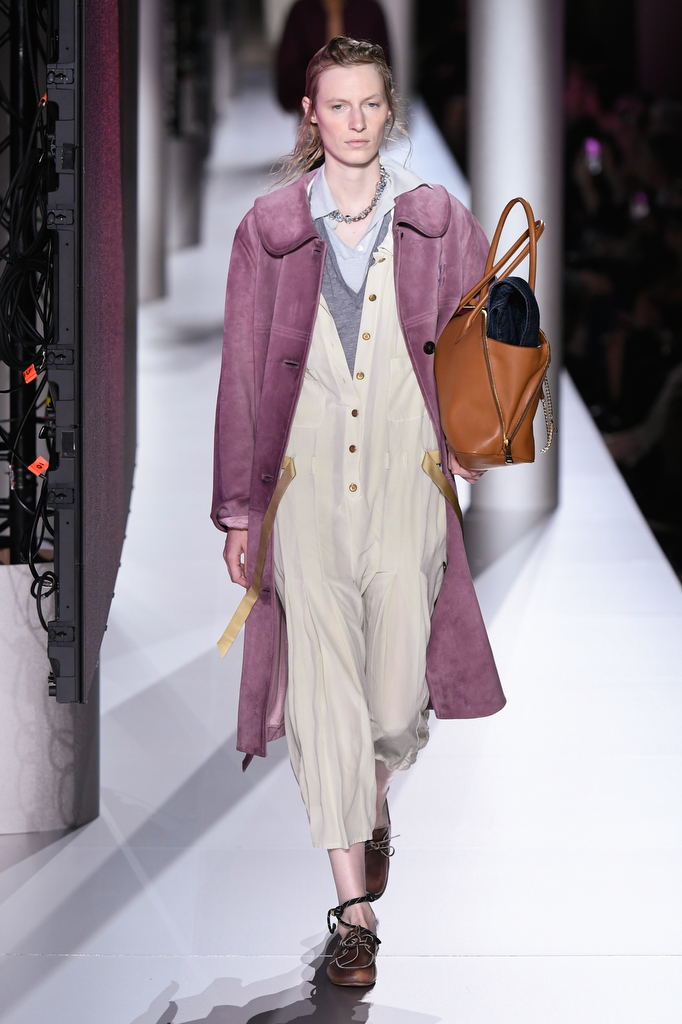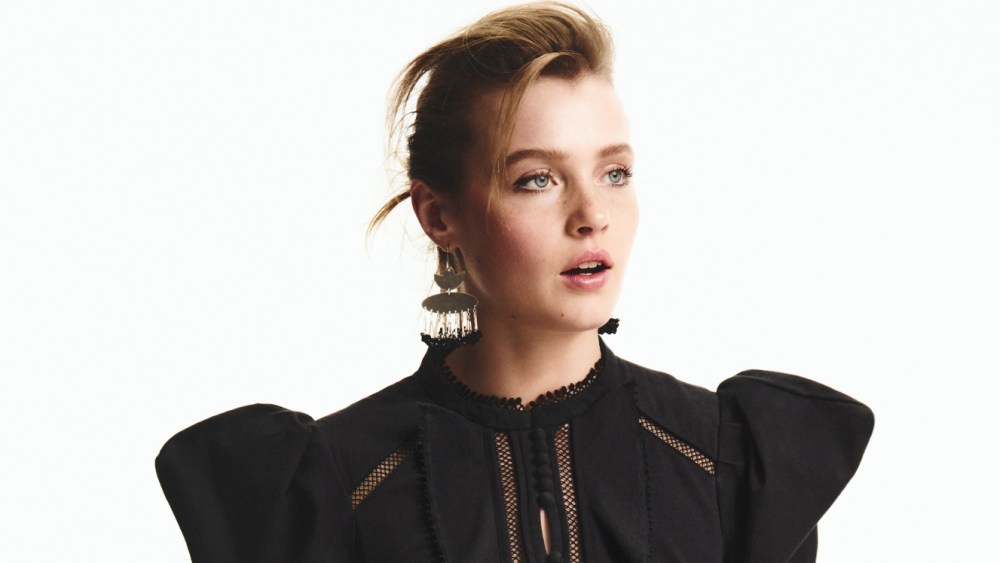MILAN — “When brand desirability is coupled with business performance, we are happy,” said Prada Group chief executive officer Andrea Guerra.
“The toughest quarter in terms of comparison is over and we were able to trail our journey without bumps,” said Guerra addressing analysts during a call on Tuesday to comment on the group’s results.
In the nine-month period ended Sept. 30, sales increased 12 percent, reaching 3.34 billion euros compared with 2.97 billion euros in the same period last year. At constant exchange rates, sales grew 17 percent.
Guerra said he was also pleased with the performance of the group in October.
The executive pointed to “further progress toward retail excellence with 11 quarters of uninterrupted full-price, like-for-like sales growth.” He admitted macroeconomic and geopolitical turbulence and tension created uncertainty, which will lead the group to focus on even better execution — “more focused and precise,” he said.
Despite that turbulence, Guerra and chief financial officer Andrea Bonini insisted throughout the call that the group’s investment strategy will not change in 2024. “We are ready for the super holiday period and we plan to move on and continue to invest, brick after brick, on our retail excellence journey,” Guerra said. “We continue to grow above industry average, and we hope to conclude 2023 as another solid year.”
Brand momentum remains strong for Prada and Miu Miu.
“Our strategy delivered solid growth in the first nine months of 2023, including in the third quarter, notwithstanding the very challenging basis of comparison,” said chairman and executive director Patrizio Bertelli, who was not on the call, in a statement. “The group continued to consolidate its brands’ desirability and accelerated investments as planned. Looking ahead, we are focused on enhancing innovation and dynamism, drawing on the strength of our reinforced organization, and on retaining the flexibility that characterizes our group.”
In the nine months, group retail sales rose 12 percent to 2.97 billion euros, and the wholesale channel reported a 4 percent gain to 291 million euros. In the third quarter, wholesale was up 10 percent on a very challenging basis of comparison, as the gain in the same period last year was of 32 percent.
In the nine months and at constant exchange rates, retail sales of the Prada brand increased by 13 percent to 2.5 billion euros, representing 84 percent of the total, driven by full-price like-for-like sales. In the third quarter, sales of the Prada brand rose 5 percent, more moderate on a very challenging comparison basis, particularly in Europe, noted Guerra.
In the nine months, Miu Miu revenues climbed 49 percent to 446 million euros. “With this kind of performance, we must be humble, there is no place for complacency, and we must keep our journey straight going forward,” cautioned Guerra. Responding to an analyst, he also underscored that it’s “Miu Miu catching up and not Prada slowing down.”
Bonini said that in terms of operating profit margins “the gap with Prada is narrowing.”
He noted that the company’s performance in the period was impacted by negative currency headwinds of 444 basis points.
Bonini did not comment on the year-end consensus, but said the group is “well-positioned with the ambition to maintain above-market growth for the year and we retain our objectives for 2024.” Guerra echoed this stance, saying that the group is “well-positioned for the fourth quarter.”
Bernstein’s Luca Solca said Prada has “significant positive momentum,” noting that the 10.3 percent organic growth in the third-quarter sales were slightly above consensus by 0.6 percent. “A further channel shift to retail (up 10.4 percent) and away from wholesale (down 1.2 percent) points to further positive progress in controlling distribution. Prada is firmly among the top companies in the sector when it comes to top line growth progression year-to-date,” especially driven by Miu Miu and ready-to-wear, growing significantly ahead of the Prada brand and leather goods. “We wonder if the progression in the third quarter of 2023 Prada has posted will be enough to support the stock, as markets are nervous about the estimated full year 2024 uncertainty for the sector, and have reacted very negatively even to very small negative surprises.”
Prices increased 4 to 6 percent in 2023, and likely show a similar increase next year, Guerra said.
During the call, no mention was made of Church’s, but the group’s presentation showed that the shoe brand posted a 19 percent decrease to 19 million euros — representing merely 1 percent of the total. In the third quarter, the first Church’s x Miu Miu collaboration was released.
In the nine months, sales of pastry shop and restaurant Marchesi and Car Shoe rose 19 percent, to 14 million euros.
Royalties soared 67 percent to 73 million euros, driven by eyewear, licensed to Luxottica, “a super business,” said Guerra, and fragrances, through a license with L’Oréal.
Prada has just launched a makeup and skin care line, which is garnering “remarkable response,” and “great growth” is expected from the category in the next two to three years, Guerra said. Asked about other potential product extensions, Guerra said there are no plans for additional licenses.
Asia Pacific progressed well over the first nine months of 2023, reporting a 15 percent increase in retail revenues to 1.04 billion euros, or a 21 percent gain at constant exchange rates, on a volatile basis of comparison, which saw significant disruption in the second and fourth quarters last year. Hong Kong and Macao showed the highest growth, Bonini said.
Sales in Europe increased 13 percent to 941 million euros thanks to local and tourist demand despite a very challenging basis of comparison. “The performance in the third quarter remained positive, with solid underlying demand, albeit with more moderate year-on-year growth, as expected,” the executive said.
Guerra said the spending of the European cluster is “obviously more normal compared with the same quarter a year ago, yet the third quarter was really, really solid. I would say things turned to normal versus two or three years ago, but for sure in some cities in the past weeks there has been more tension for the macro political situation, but we have not seen basic differences so far.”
Revenues in the Americas were down 3 percent to 536 million euros with what the company called “a mild sequential improvement” in the third quarter compared with the second quarter.
Japan remained the best-performing region, with sustained growth throughout the period and sales gaining 34 percent to 334 million euros, largely driven by local demand. At constant exchange rates, revenues rose 47 percent in that market, boosted mainly by local spending, but Guerra noted that there has been a progressive increase of travelers, especially from China, in the past three to five months — although the levels of pre-pandemic tourism “is still a long way away.”
The Middle East delivered a solid performance, showing a 10 percent increase to 125 million euros.
By category, ready-to-wear was the fastest growing, showing a 32 percent increase to 923 million euros in the nine months, or 31 percent of the total.
Leather goods, still the biggest contributor to the group, accounting for 47 percent of total sales, was up 8 percent in the nine months to 1.4 billion euros, and up 1 percent growth in the third quarter. Prada has been focusing on signature bags, such as the Galleria, while launching new designs, and Miu Miu has also shone light on the Arcadie and Wander bags.
Asked about the slowdown in the category, Guerra said the leather goods market saw “an unbelievable dimensional increase” in this business in the 2020-22 period, due to the pandemic and social distancing, but now “leather goods are [generally] taking a kind of a breather, but we are happy. Could we have done better? Always, but this is one of the best results of the quarter and we continue to move on, nothing is decelerating, we have a strong portfolio of products going forward,” he trumpeted.
He offered that “the first conversation has to be about the entry price to be more competitive, to achieve a wider range of prices going upward, but the top of range needs substance for desirability and long-term value.” He believes there has been a shift in the market where the focus is style and design, and not the price, he said.
Footwear was up 16 percent to 556 million euros, lifted by both sneakers and formal shoes.



